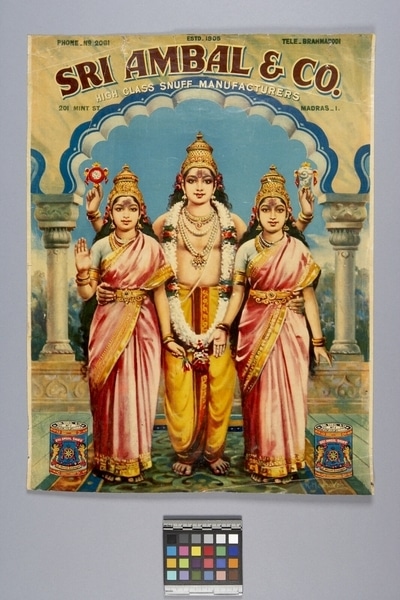Calendar Item Number: Eg153 from the MOA: University of British Columbia

Description
Rectangular calendar print depicting Vishnu, a four-armed male flanked by two females with long, dark hair, wearing red and white streaked saris. He stands slightly behind while holding each female around waist with one hand. All forward-facing, wearing gold crowns, and having dry brown powder at centre of foreheads. Powder covers male's red u shape symbol and females' red dot symbols. Vishnu is wearing a floor-length, red-trimmed dhoti, a white, green and pink striped floral garland and pearl necklaces. He is holding two objects up above females' heads: on left, red circular object with white face; on right, white rolled object; both with red and yellow ornaments and tassels. Female on left holds red flower in hand on right and raises palm of hand on left. Female on right has palm of dropped arm on left, facing outward. Three stand on green-patterned carpet inside white column and arch structure. Background is blue sky. Snuff container illustrated in each lower corner; blue as main colour. At calendar's top, advertisement for 'Sri Ambal & Co., High Class Snuff Manufacturers' in brown and white lettering.
History Of Use
Indian popular religious prints have been published for nearly a century, first by German presses, later by Indian ones. The prints may take the form of calendars, posters, or simply images. The style of the representations is European. In the beginning they were Hindu images, but are now acquiring elements both of folk art and a romantic secularism. It is a living art currently influenced by the movie industry and non-Hindu religions. The images are a vehicle for advertising and are also used for religious purposes.
Cultural Context
calendar art; popular religious art
Iconographic Meaning
Vishnu, preserver of the universal order, establishes law and order and protects the world from evil and destruction through ten earthly incarnations. He is identified by: rotating discus; six-petaled lotus; mace symbolizing his power of knowledge; white conch shell; gold crown; and his flying mount, Garuda. In this print, he is identified with his two consorts, Sri Devi and Bhu Devi.
Item History
- Made by K. Madhavan (Maker) in India during 1950
- Collected before 1982
- Owned by Stephen Inglis before January 1983
- Received from Stephen Inglis (Donor) during January 1983
What
- Name
- Calendar
- Identification Number
- Eg153
- Type of Item
- calendar
- Overall
- height 46.9 cm, width 35.7 cm
Who
- Culture
- South India
- Creator
- K. Madhavan (Maker)
- Previous Owner
- Stephen Inglis
- Received from
- Stephen Inglis (Donor)
Where
- Holding Institution
- MOA: University of British Columbia
- Made in
- India
When
- Creation Date
- during 1950
- Collection Date
- before 1982
- Ownership Date
- before January 1983
- Acquisition Date
- during January 1983
Other
- Item Classes
- works on paper
- Condition
- fair
- Accession Number
- 0857/0007